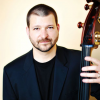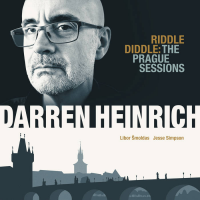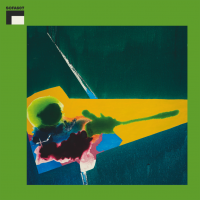Home » Jazz Articles » Album Review » Jeff Rupert/George Garzone: The Ripple
Jeff Rupert/George Garzone: The Ripple
Here Jeff Rupert and George Garzone join together to explore the endless possibilities of improvisation. Rupert is well invested and keyed in on the intricacies of Young, as well as other big sound creators like Ben Webster and Coleman Hawkins. If you are familiar with Garzone, then you already know that he is as big, bold, and adventurous as they come. If you are looking for a record with two saxophonists "dueling" to the death, then you should probably keep looking. This isn't intended as a shootout at the OK Corral. It is intended, and well delivered, as a cohesive quintet on the same page uniting together with the best interest of every song as the objective.
Rupert put this project together. He is to be credited with fine selections of classic material and arrangements that brought out their beauty. Three stout Rupert originals bind seamlessly with the vintage. Of note is that his arrangements also left a lot of room for Garzone to do what he does best. His deeply nuanced note selections contrast brilliantly with Rupert's melodic lines. The contrast, as will be discussed, goes further, and is a large part of this record's dynamic allure.
Both artists clearly have a vested interest and relationship with the music and technique of Getz. However, those relationships are unique to themselves. That is to say, Getz's music was heard and imparted into Garzone's head in a different way than it was processed by Rupert, or any other player. It is yet another layer of individuality that heightens the contrasts and makes this record so appealing.
"Bahia" is an instant attention grabber. Rupert and Garzone forego the awkward beginnings of a conversation, emitting fluently expressive vocabulary from start to finish. It is a sign of things to come, as the tenors are at ease delicately dictating the pulse and sway. Within the framework of Rupert's original, "Go-Go," things get heated. The animated exchange is fueled by a rhythm section that levels the playing field. Staying within themselves, Rupert is nonetheless pushed to the edge by a relentless Garzone, Rupert having cleverly composed a tune in which he set himself up to be stretched. He also empowers Garzone to do the same.
Back to the standards, "Stardust" bursts onto the scene with Garzone's robust tenacity. Rupert then gleefully takes a run through the Hoagy Carmichael tune, prior to the two distinctive voices merging and emerging as one. The rhythm section is again spot-on and critical to doing justice to this iconic piece. As if at a live show, let's pause to introduce these pillars of the foundation.
Pianist Richard Drexler, drummer Marty Morell, and bassist Jeremy Allen not only complete the quintet but are a vital cog in the wheel of sublime jazz renderings. This is a trio of superb veteran musicians that tightly hold together the grooves. Their patience and control are essential in allowing the two tenors to stretch, navigate, and expand freely. These cats are strong when they needed to be but are rightfully more concerned with the overall sound of the ensemble.
An encounter with bebop, and a nod to Joe Henderson, features an understated, but ripe, Rupert entangled with a full-on and filthy Garzone, on a superbly arranged version of "Without A Song." Drexler, Morell, and Allen shine again and are responsible for their propensity of creating space in which the tenors roam free to push boundaries and pay it forward. "The Shadow of Your Smile" has long been considered a contemporary classic, but not necessarily a jazz tune. Morell and Allen set a mood and tempo here that paves the way for the two tenors to imaginatively express the well-known and lusciously romantic melody. Unexpectedly, this arrangement personifies the core representation of jazz that can be enjoyed in a leisurely fashion, or listened to more distinctly with its enclave of purposeful note selections and changes that are in abundance throughout the record.
The lush magic of Sarah Vaughan is sweetly reimagined with "Detour Ahead." A ballad that Vaughan brought both attention and her singular grace. Here it is embraced with fluidity and textured with tranquility. When "The Red Door"—composed and originally swung by Gerry Mulligan and Zoot Sims—is reopened, you are welcomed into a redecorated home with an all new swing set. Rupert and Garzone bring their own oil to the hinges and swing freely. "The Red Door" is followed by Lionel Hampton's "Red Top." This bop is a defining moment in Rupert's and Garzone's willingness and ability to stay in their own lanes, then light up together at the intersections. Drexler adroitly exudes the Hampton vibe on his keys.
A trip to "Hoboken" comes along. The Rupert-penned tune lends itself to the innate synchronicity of the quintet. Played with verve, it lends itself to the old "that's a real toe tapper" phrase. Co-written by Rupert and Veronica Swift, "Beauty Becomes Her" was first heard, with Swift providing the vocal, on Rupert's record Let's Sail Away (Rupe Media, 2017). This instrumental take has the warmth and tenderness of Garzone's and Rupert's lines evoking the lazy afternoon sun spawning into the shimmering glow of the sunset.
Wayne Shorter's moving homage to Lester Young, "Lester Left Town," was clearly an appropriate choice based on the theme of this project. It turned out to be an even more appropriate finale for the quintet, in that they brought their own heart and sensibilities to the fore. In the end, Garzone and Rupert are "Alone Together," sans the trio, and have a private and learned conversation with some accomplished vocabulary you won't find in your Funk & Wagnalls.
Track Listing
Bahia; Go-Go; Stardust; Without a Song; The Shadow of Your Smile; Detour Ahead; The Red Door; Red Top; Hoboken: Beauty Becomes Her; Lester Left Town; Alone Together.
Personnel
Jeff Rupert
saxophoneGeorge Garzone
saxophone, tenorRichard Drexler
bass, acousticMarty Morell
drumsJeremy Allen
bass, acousticAlbum information
Title: The Ripple | Year Released: 2020 | Record Label: Rupe Media
Tags
PREVIOUS / NEXT
Support All About Jazz
 All About Jazz has been a pillar of jazz since 1995, championing it as an art form and, more importantly, supporting the musicians who make it. Our enduring commitment has made "AAJ" one of the most culturally important websites of its kind, read by hundreds of thousands of fans, musicians and industry figures every month.
All About Jazz has been a pillar of jazz since 1995, championing it as an art form and, more importantly, supporting the musicians who make it. Our enduring commitment has made "AAJ" one of the most culturally important websites of its kind, read by hundreds of thousands of fans, musicians and industry figures every month.
























